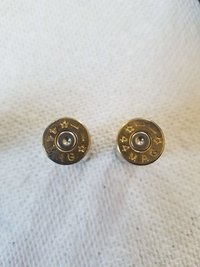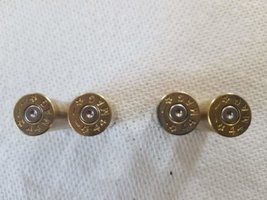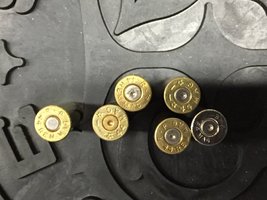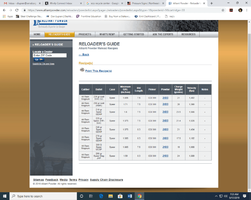Question for experienced re loaders especially those familiar with Magnum Pistol Loads:
Both loads fired in a ruger redhawk 5.5" barrel revolver, load 1 was fired from a clean gun load 2 was fired after 10 rounds through it. Temp 72 degrees 44% humidity
Load 1 .44 Magnum, Nosler 200gr JSP, 20.8 Gr Alliant 2400, CCI LP primer (the starting load in the Nosler Manual. Never fired Starline brass
Shot well, primers appeared slightly flattened but otherwise no other pressure signs
Load 2. .44 Magnum Nosler 200gr JSP, 21.3 Gr Alliant 2400, CCI LP primer (The midlevel load [of 3] in the Nosler Manual. Never fired Starline brass
Shot well but noticed a noticeable amount of soot on the rim of the case. Also extraction was a bit stickier.
Load 2 see below (notice the soot around the rim)

Load 1 on LEFT Load 2 on RIGHT for comparison

My question is: Am I beyond the threshold and should back off. My inclination is that yes I should. Though this load is still before maximum according to the Nosler reloading handbook and other handbooks list 2400 loads greater with similar bullet designs. My experience in reloading has been to only reload to around mid level loads, I have never approached the edge of the envelope yet and would like to learn from other's experience. Thank you ahead of time.
Both loads fired in a ruger redhawk 5.5" barrel revolver, load 1 was fired from a clean gun load 2 was fired after 10 rounds through it. Temp 72 degrees 44% humidity
Load 1 .44 Magnum, Nosler 200gr JSP, 20.8 Gr Alliant 2400, CCI LP primer (the starting load in the Nosler Manual. Never fired Starline brass
Shot well, primers appeared slightly flattened but otherwise no other pressure signs
Load 2. .44 Magnum Nosler 200gr JSP, 21.3 Gr Alliant 2400, CCI LP primer (The midlevel load [of 3] in the Nosler Manual. Never fired Starline brass
Shot well but noticed a noticeable amount of soot on the rim of the case. Also extraction was a bit stickier.
Load 2 see below (notice the soot around the rim)

Load 1 on LEFT Load 2 on RIGHT for comparison

My question is: Am I beyond the threshold and should back off. My inclination is that yes I should. Though this load is still before maximum according to the Nosler reloading handbook and other handbooks list 2400 loads greater with similar bullet designs. My experience in reloading has been to only reload to around mid level loads, I have never approached the edge of the envelope yet and would like to learn from other's experience. Thank you ahead of time.
Last edited:


